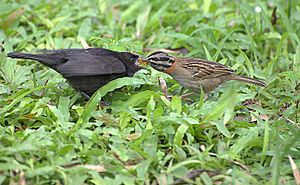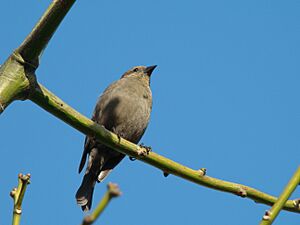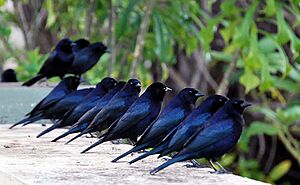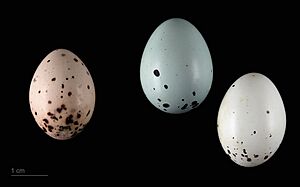Shiny cowbird facts for kids
Quick facts for kids Shiny cowbird |
|
|---|---|
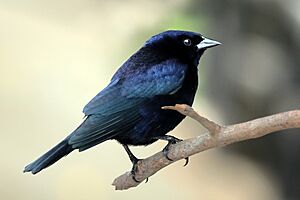 |
|
| Adult male | |
| Conservation status | |
| Scientific classification | |
| Genus: |
Molothrus
|
| Species: |
bonariensis
|
 |
|
| Resident | |
The shiny cowbird (Molothrus bonariensis) is a small passerine bird found in the New World. It belongs to the Icteridae family. These birds live in most of South America, but they avoid thick forests and very high mountain areas.
Since the 1900s, the shiny cowbird has spread northward. It has been seen in the Caribbean islands and even in southern Florida in the United States. This bird likes open spaces, including areas changed by agriculture and deforestation.
Male and female shiny cowbirds look different. Males are completely black with a shiny purple-blue color. Females are smaller and dull brown. Their bellies can be a bit lighter. Female shiny cowbirds have longer, thinner beaks and flatter heads compared to female brown-headed cowbirds. Shiny cowbirds mostly eat insects, other small creatures, and seeds. They have also been seen eating grains from where cattle feed.
Like most other cowbirds, the shiny cowbird is a "brood parasite." This means it lays its eggs in the nests of other bird species. One common host is the rufous-collared sparrow. Different host birds react differently. Some accept the cowbird eggs and raise the chicks. Others try to get rid of the eggs. The shiny cowbird is very good at being a brood parasite. It is like the South American version of the brown-headed cowbird.
Contents
About the Shiny Cowbird
The shiny cowbird was officially named in 1789 by a German scientist named Johann Friedrich Gmelin. He first put it in a group with tanagers. The name bonariensis comes from Buenos Aires, which is where the bird was first found. Today, the shiny cowbird is one of six cowbird species in the group called Molothrus.
There are seven different types, or subspecies, of shiny cowbirds:
- M. b. minimus: Found in south Florida, the West Indies, and northern Brazil.
- M. b. cabanisii: Lives from eastern Costa Rica to western Colombia.
- M. b. venezuelensis: Found in eastern Colombia and northern Venezuela.
- M. b. aequatorialis: Lives in southwest Colombia and western Ecuador.
- M. b. occidentalis: Found in southwest Ecuador and western Peru.
- M. b. riparius: Lives in eastern Ecuador, eastern Peru, and western Brazil.
- M. b. bonariensis: Found in central and eastern Brazil, central Chile, Bolivia, and central southern Argentina.
What Shiny Cowbirds Look Like
The size and look of adult shiny cowbirds can vary depending on their subspecies. They can weigh from 31 to 65 grams. Their length can be from 18 to 22 centimeters.
Most male shiny cowbirds have black feathers with a shiny purple-blue color. Females are usually dusty gray-brown. Some subspecies have slightly different colors. For example, some females might be paler or have darker heads.
When shiny cowbird chicks hatch, they are helpless and stay in their nests. They are covered in soft gray down. Young males are dark on top with dull gray bellies that have dark streaks. Young females are buff brown on top with lighter bellies.
Shiny cowbird eggs are oval-shaped. They can be white with spots or completely white without spots. Sometimes they are light blue, light gray, or a buff color.
Where Shiny Cowbirds Live
Shiny cowbirds live all year in most of South America. They prefer open areas like open forests and farmland. Over the last 100 years, they have moved northward into the West Indies and southern Florida.
This spread is happening because humans are changing forests into open farms and fields. Shiny cowbirds like these open habitats. Moving into new areas allows them to find new bird species whose nests they can use. These new host birds may not know how to protect their nests from cowbirds.
How Deforestation Helps Them Spread
When forests are cut down and turned into farms or pastures, it creates more open land. This helps the shiny cowbird spread because they love open habitats. These deforested areas might have host birds that have never dealt with cowbirds before. These "naive" host birds probably don't have ways to defend their nests. This means the cowbirds can affect them more negatively.
The shiny cowbird spread from South America to Puerto Rico in 1955. Then it reached the Dominican Republic in 1973 and Cuba in 1982. Since 1985, shiny cowbirds have been seen in Florida.
Shiny Cowbird Behavior
Reproduction: Brood Parasitism
The shiny cowbird is an obligate brood parasite. This means adult cowbirds lay their eggs in the nests of other bird species. Their young then rely completely on these "host" birds to raise them. They are "generalists," meaning they use about 250 different host species! Their chicks do not try to act like the host chicks. In parts of South America, like Argentina and Brazil, the main host bird is the rufous-collared sparrow.
Female shiny cowbirds do not build their own nests. They depend on host birds to care for their babies. They often choose hosts that build nests in hidden spots or cavities. They look for nests by actively searching or by quietly watching other birds. When a female cowbird finds a nest, she might fly around noisily to scare the host bird away. One shiny cowbird can lay eggs in many different nests.
